Should I drill a hole in my engine block?
#61
Sorry, not sure what blend means. Motor is almost done. The plan is to run this vent separately to atmosphere via a clear hose and clear container to see if it's playing nice with the rest of the motor. Next step would be clear hose to the rest of the catch can system and see how that works, then black hose.
With one way check valves used.
This way there will be neg pressure applied to catch can, to pull the vapors into the catch can.
With a properly made catch can, the vapor and other crud will be left in the catch can, and clean air pulled into the vac. sorce.
#65
Senior Member

Thread Starter
iTrader: (4)
Join Date: Feb 2011
Location: Crest Hill, IL
Posts: 742
Total Cats: 42
I finally got around to finishing the story as to what I did and how it works.
Out of the engine block through an air oil seprator (inside is stainless pot scrubber material) to the back of the valve cover. What this does is create another exit for gasses other than the existing oil drain back hole. Which under boost oil pools in the head. The air oil seprator isn't perfect, so any oil that makes it's way that far up is returned back to the motor. Then the gasses are ran through the valve cover baffels (again, with fluffed up stainless pot scrubber material) and out to a catch can which has a slash cut before the turbo.
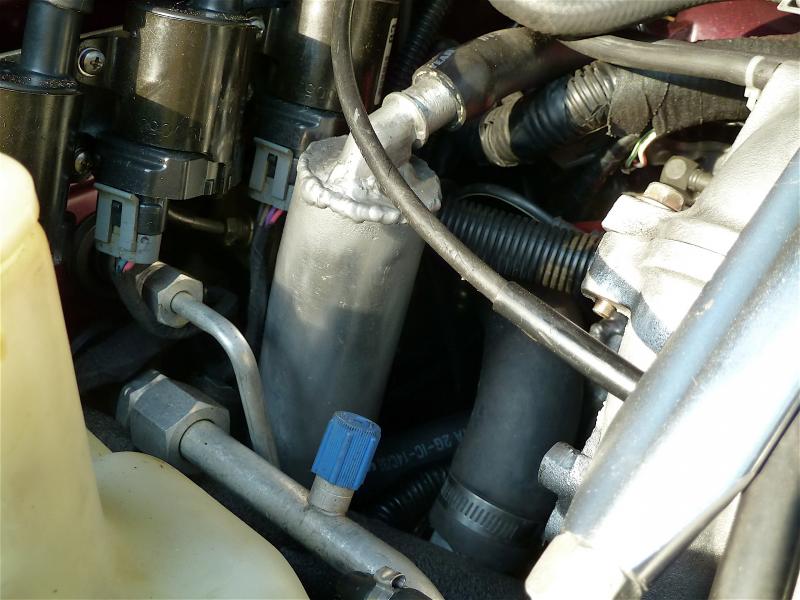

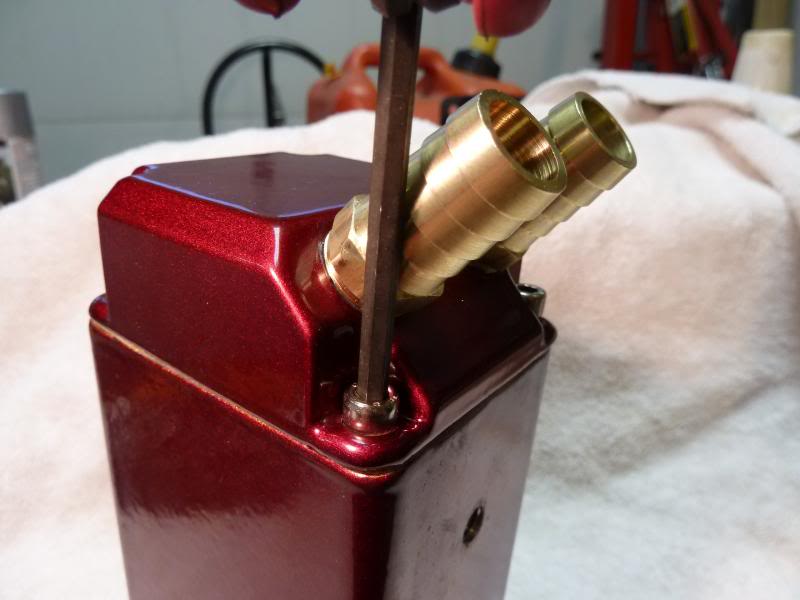

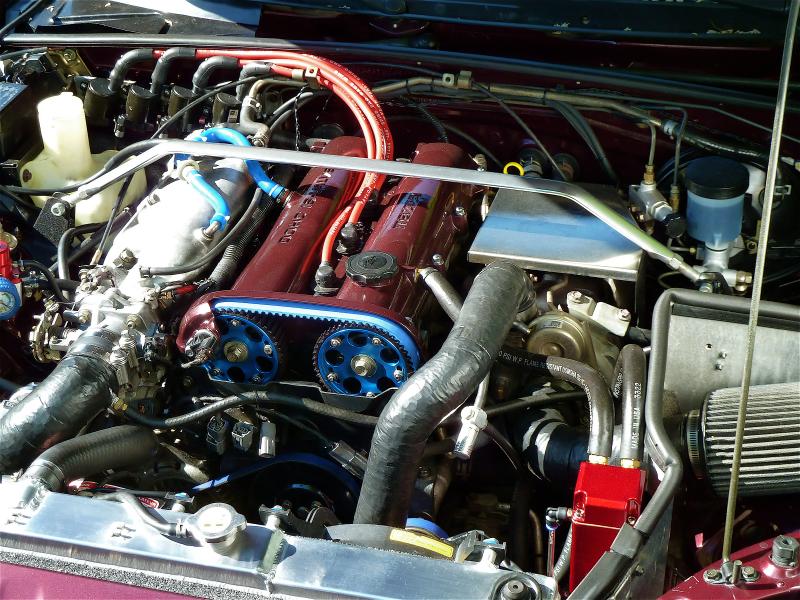
Everything has been drilled out to 1/2" I.D. Between the manifold and valve cover I used a Honda one way valve that is used on their brake boosters. Very robust valve, can handle 30+ psi.
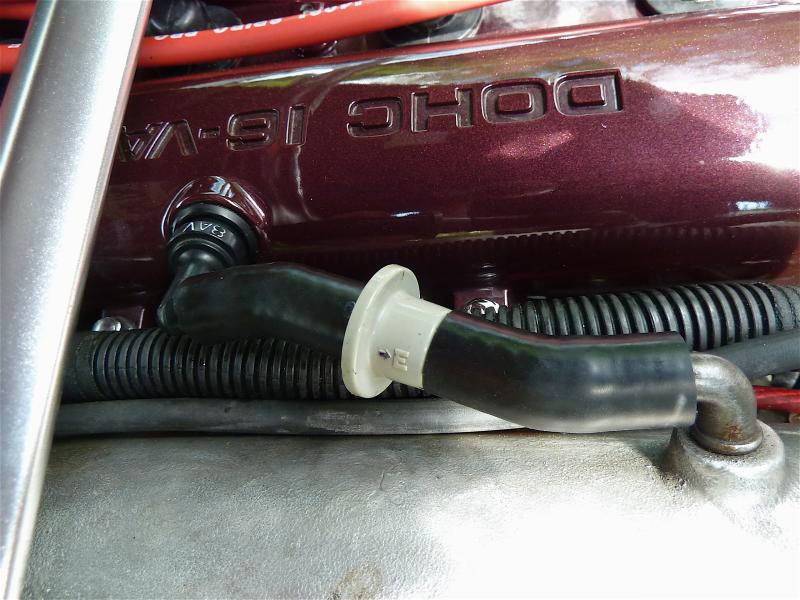
So far this seems to well and have measured no positive engine pressure at 16 lbs of boost.
Out of the engine block through an air oil seprator (inside is stainless pot scrubber material) to the back of the valve cover. What this does is create another exit for gasses other than the existing oil drain back hole. Which under boost oil pools in the head. The air oil seprator isn't perfect, so any oil that makes it's way that far up is returned back to the motor. Then the gasses are ran through the valve cover baffels (again, with fluffed up stainless pot scrubber material) and out to a catch can which has a slash cut before the turbo.





Everything has been drilled out to 1/2" I.D. Between the manifold and valve cover I used a Honda one way valve that is used on their brake boosters. Very robust valve, can handle 30+ psi.

So far this seems to well and have measured no positive engine pressure at 16 lbs of boost.
#66
Boost Pope


iTrader: (8)
Join Date: Sep 2005
Location: Chicago. (The less-murder part.)
Posts: 33,017
Total Cats: 6,587
Too many details, too much plausibility.
You need to just make some vague and outlandish claims without actually justifying what you have done or showing us detailed images of how it goes together.
You need to just make some vague and outlandish claims without actually justifying what you have done or showing us detailed images of how it goes together.
#67
I'm confused. So you connected the hole in the block to the head, so its basically a balance tube, but then you put an AOS in the line. That AOS does nothing, remove it. OR connect that AOS to your slashcut rather than the head. But if you're just making a balance tube between the head and the block there's no need for an AOS.
#68
Senior Member

Thread Starter
iTrader: (4)
Join Date: Feb 2011
Location: Crest Hill, IL
Posts: 742
Total Cats: 42
I'm confused. So you connected the hole in the block to the head, so its basically a balance tube, but then you put an AOS in the line. That AOS does nothing, remove it. OR connect that AOS to your slashcut rather than the head. But if you're just making a balance tube between the head and the block there's no need for an AOS.
I think the next variation would be to have a separate line from the AOS into the catch can. That way you can still monitor any oil getting by from this design.
I encourage you to take this as a starting point and try to improve it.
This could also be viewed as trying to solve a problem that doesn't exist. Which is OK too. But with people running higher boost and horsepower the tiny little drain back hole isn't gonna cut it.
#69
It took a bunch or searching to find this actually.
I'd like to apologize for calling the AOS in the balance tube stupid, it might actually catch a bunch of oil and prevent it from getting to the catch can.
How well has this been running? I think I'm currently generating a bunch of blow by which is why I cant keep oil to stay in the block. Its leaking the most from the rear passenger side of the valve cover, but its really coming out pretty much every orifice of the damn car. I'm thinking, this hole + the hole bundy is using + a -10 replacing the valve cover. Then with VC -> catch can -> check valve -> turbo inlet
Both block holes -> catch can -> slash cut with check valve AND pcv valve with check valve to intake manifold
PVC hole in VC block
Bundy, was the hole you drilled easy to clean out with the pan off the car? And how close is that clearance to the alternator really? And would you be able to remove the stock style bolt that goes out the back with the fitting?
I'd like to apologize for calling the AOS in the balance tube stupid, it might actually catch a bunch of oil and prevent it from getting to the catch can.
How well has this been running? I think I'm currently generating a bunch of blow by which is why I cant keep oil to stay in the block. Its leaking the most from the rear passenger side of the valve cover, but its really coming out pretty much every orifice of the damn car. I'm thinking, this hole + the hole bundy is using + a -10 replacing the valve cover. Then with VC -> catch can -> check valve -> turbo inlet
Both block holes -> catch can -> slash cut with check valve AND pcv valve with check valve to intake manifold
PVC hole in VC block
Bundy, was the hole you drilled easy to clean out with the pan off the car? And how close is that clearance to the alternator really? And would you be able to remove the stock style bolt that goes out the back with the fitting?
#70
This would replicate the stock breather line from the VC to the intake tube. Would you need the catch can in this line with the check valve preventing flow of oily air from VC->Turbo Inlet? Is this even necessary without an AFM? IIRC, the reasoning for it on an AFM is the fresh air going in is measured (line is post-AFM in intake tube), because we can't measure the PCV air into the manifold. On a non-AFM car, couldn't this just be replaced with one of those K&N breathers and a check valve?
Crankcase pressure would be vented to the slashcut under boost or recycled to the intake manifold under vacuum, with a catch can to stop from making clouds or gunking up the exhaust manifold.
The PCV side sounds perfect. Anyone with more knowledge than I have an opinion on the breather?
Edit: Found this while searching for catch cans. http://www.unysoc.org/board/index.php?topic=9291.0
Seems easy enough to fabricate. Plumb the top to the slashcut, the two sides to the block holes, and the bottom to a drainback hole, and you'd have a sealed no-maintenance unit. The baffle system looks pretty good.
Edit 2: I've been searching, what hole is bbundy using? Can't seem to pull anything up in search.
Edit 3: Duh. It's on page two of THIS VERY THREAD.
Both block holes -> catch can -> slash cut with check valve AND pcv valve with check valve to intake manifold
The PCV side sounds perfect. Anyone with more knowledge than I have an opinion on the breather?
Edit: Found this while searching for catch cans. http://www.unysoc.org/board/index.php?topic=9291.0
Seems easy enough to fabricate. Plumb the top to the slashcut, the two sides to the block holes, and the bottom to a drainback hole, and you'd have a sealed no-maintenance unit. The baffle system looks pretty good.
Edit 2: I've been searching, what hole is bbundy using? Can't seem to pull anything up in search.
Edit 3: Duh. It's on page two of THIS VERY THREAD.
Last edited by TheScaryOne; 12-04-2013 at 07:35 PM.
#71
This would replicate the stock breather line from the VC to the intake tube. Would you need the catch can in this line with the check valve preventing flow of oily air from VC->Turbo Inlet? Is this even necessary without an AFM? IIRC, the reasoning for it on an AFM is the fresh air going in is measured (line is post-AFM in intake tube), because we can't measure the PCV air into the manifold. On a non-AFM car, couldn't this just be replaced with one of those K&N breathers and a check valve?
I had also considered running all 3 engine holes into 1 big can and then running 3 lines from that to all the other spots since I wouldnt have the vac source cross talk due to the having a million check valves aspect.
#72
Elite Member
iTrader: (12)
Join Date: Nov 2009
Location: Harpers Ferry WV
Posts: 1,516
Total Cats: 20
I do not want to sound negative because this system looks like it will work and seems to be working for you, but I think it is way over complicated for a breather setup. I run a different engine in my car currently with two 10an lines one from each valve covet with a t fitting tying them together to a slash cut in the exhaust. This works fantastic no dirty catch can no dripping oil no blow by and my car only uses about 1/4 quart of oil over 3000 miles. Simple and effective.
I dont want you to think I am bashing you breather setup it is very nice but with a nice turbo kit and your engine bay looking nice I dont see why anyone would want to suck oil vapor back into your turbo. Maybe I missed something along the line but seems way way over kill.
I dont want you to think I am bashing you breather setup it is very nice but with a nice turbo kit and your engine bay looking nice I dont see why anyone would want to suck oil vapor back into your turbo. Maybe I missed something along the line but seems way way over kill.
#74
On my Subaru I just run all PCV from valve covers with check valves into a catch can from a Volvo 850 I believe. The outlets run to the intake manifold with a check valve (no boost) and one goes to the intake. The last outlet on the bottom is a drain back a high boss on the block that the turbo drains to as well... Doesn't look the best, but it solved my problem I was having...

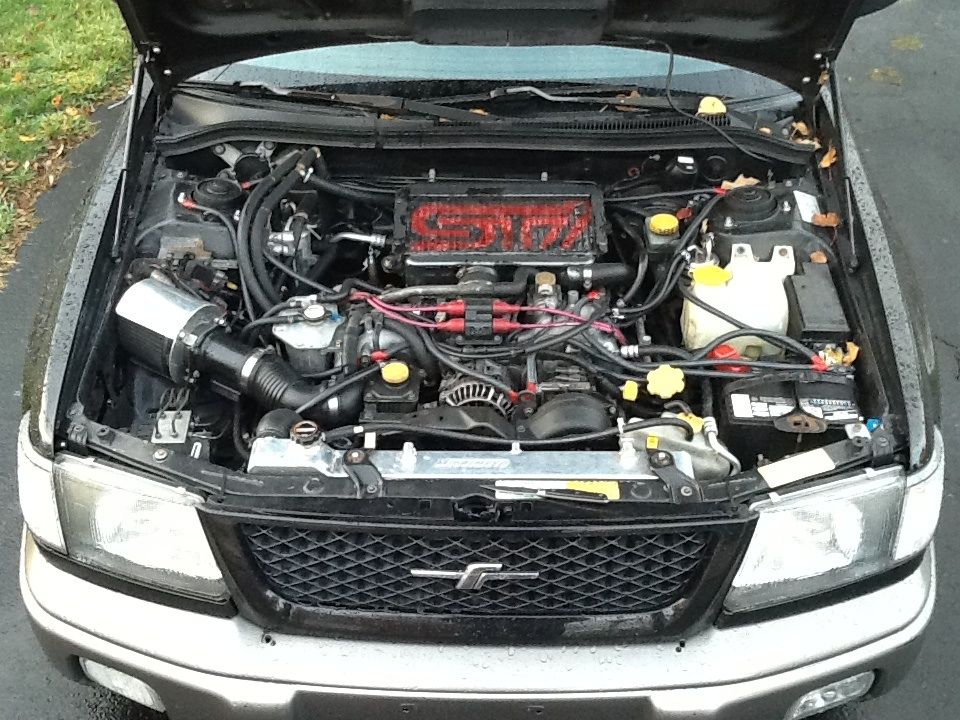


#76
You'll have to measure the pressure inside the block when you're done. If you do that you should always be under vacuum except at idle. In that case yea, the three lines to the catch can would make total sense. I'd guess you'd Y the vacuum between the turbo inlet and the slashcut to pull on the can. Both should be pulling vacuum at the same time, so I don't know if a check valve would be necessary on the turbo inlet (can't think of a situation that would cause pressure there).
Edit: But a check valve would prevent it from sucking in air if overwhelmed by the slashcut.
Another idea would be to run a separate coalescing filter on the turbo inlet instead of a catch can. Breather > Coalescing filter > Turbo Inlet
HE Air/Oil Separator Page
Edit 2: Or put the slashcut/turbo inlet on the vacuum side of a particulate filter/coalescing filter combo, and run the three block hoses into a simple vacuum manifold. See results of particulate/coalescing combo here: http://forums.corvetteforum.com/c5-t...-continue.html
Edit: But a check valve would prevent it from sucking in air if overwhelmed by the slashcut.
Another idea would be to run a separate coalescing filter on the turbo inlet instead of a catch can. Breather > Coalescing filter > Turbo Inlet
HE Air/Oil Separator Page
Edit 2: Or put the slashcut/turbo inlet on the vacuum side of a particulate filter/coalescing filter combo, and run the three block hoses into a simple vacuum manifold. See results of particulate/coalescing combo here: http://forums.corvetteforum.com/c5-t...-continue.html
Last edited by TheScaryOne; 12-05-2013 at 01:13 PM.
#77
Elite Member
iTrader: (37)
Join Date: Apr 2010
Location: Very NorCal
Posts: 10,441
Total Cats: 1,899
I had the top of my intake manifold off the other day, looks like a BP oil rig is parked somewhere in my intake tract.  Time for a catch can methinks.
Time for a catch can methinks.
I like that glass bodied one in the link above, but will probably just order the little Moroso one.
 Time for a catch can methinks.
Time for a catch can methinks.I like that glass bodied one in the link above, but will probably just order the little Moroso one.
#78
Here are the cheaper options. The guy (Dave68) runs the Conceptual Polymers.
Online prices show $34 each for the assemblies. Particulate filter has a plastic bowl, coalescing filter has a zinc bowl. Both have drains and seem to be 1 oz capacity. I think you can buy just his extended housing from him, or have someone DIY.
Watts 504-02DH (a particulate filter that is a bit more "open" when compared to the F501 coalescing filter). This is followed by the Watts F501-02DHX67 (coalescing filter that includes a mounting bracket).
#80
There's also this one, which I was considering for the VC->intake connection. It'll be easier to fit into the car, and seem to cost about $45. Would probably T it into my turbo drain. Yes, yes I'm the biggest opponent of re-introducing pcv oil back into the crank case, BUT the PCV valve ends up sucking up the most of the really nasty things in street driving (in theory), and my car gets about 800 miles between oil changes.











